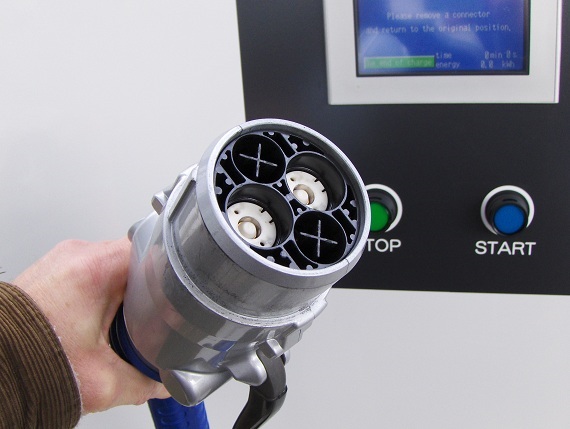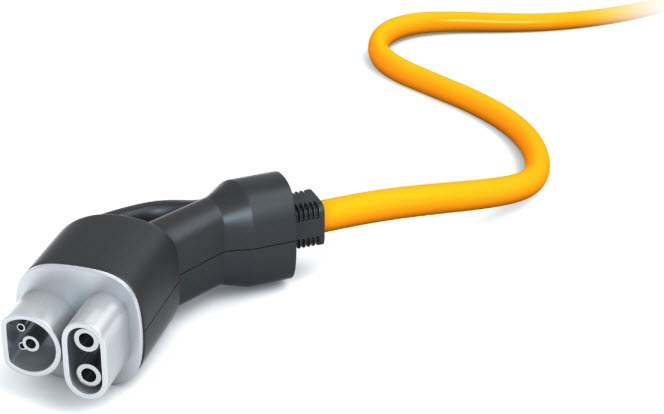In the last installment of this series, I explored different standards around the connection of alternating current (AC) voltage to an electric vehicle. In all of those cases, the electric vehicle (EV) has an onboard AC-to-DC (direct current) converter to handle much of the complex portion of the power-delivery equation. However, due to space constraints and the increased difficulty of designing automotive-grade electronics, these onboard converters are typically less than 10kW. To really get the power flowing, you’re going to need to move the AC to DC conversion off the car.
The generic name for these off-board AC/DC charging standards is DC fast charge. This encompasses a wide range of emerging standards worldwide, but let’s look at the basic requirements of such a system before tearing into the variants.
The key benefit of an off-board AC-to-DC converter is going to be the amount of power it can deliver. Without the size constraints, the system power-delivery limit quickly approaches that of the battery and the electrical service line to the station. Many of these stations are specified by how many miles of range they deliver per hour or charge. While this can serve as a decent quick measure to an end user, a more useful specification is kilowatts. To put the newer DC chargers into perspective when compared to their AC brethren, 50-60kW is fairly common, with some exceeding 100kW.
In order to remove the need for any additional power-conversion stages on the vehicle, the DC voltage levels coming out of the charger will need to be on the same level as the onboard battery system, or approximately 400-500VDC. The output voltage of the charger varies depending on the individual vehicle make and model, pack chemistry, and charge characteristics. To maintain tight voltage control, digital power controllers can monitor and control the output in real time based on the needs of the vehicle.
Even with a tight control loop on a digital power controller, delivering this much energy into a vehicle can be tricky without knowing exactly how much it needs to properly charge the batteries. Communication between the vehicle and the station is once again a must, but the pilot signal wire used in Level 1 and 2 stations just won’t cut it here. Modern Level 3 charging stations will connect directly to the internal network of the vehicle over the controller area network (CAN) or the local interconnect network (LIN) bus, or via another high-speed interface like HomePlug Green PHY power line communication (PLC).
There are currently three standards for DC fast charge available to automakers right now:
- CHAdeMO is a charging standard built from the ground up for high voltage (HV) DC quick charging. It’s capable of delivering up to 62.5kW of energy via its Type-4 connector. For high-speed communication, CHAdeMO connects directly to the CAN bus on the vehicle through two dedicated pins in the connector. See Fig. 1 image of a CHAdeMO connector.
- The Combined Charging System is an extension of the J1772 Level 1 and 2 charge standard. It adds an additional two contacts for the HV DC. By keeping the upper half the same, a vehicle can accept either a Level 1 and 2 AC charger, or the Level 3 charge via the same input. To facilitate communication, the connector uses HomePlug Green PHY PLC over the DC link, and can support up to 100kW of energy delivery.
- The Tesla Supercharger is a proprietary DC link capable of delivering 120kW of energy to the vehicle.
With the simultaneous rollout of both the CHAdeMO and Combined Charging System stations worldwide, EV manufactures face a tough choice about which standard to include in their vehicle to best suit their customers.
The limited support in current-generation plug-in EVs is slowing the rollout of these new high-power chargers, but within a few years it could become standard on all EVs. Due to their cost and complexity, DC chargers won’t likely see a place in an EV owner’s home (where they can afford to be plugged in all night to charge a vehicle on a Level 1 or 2 station). This does not reduce their utility, however, as the most attractive location for EV high-speed charging will likely be along major highways between large cities, enabling people to drive further than ever on pure electricity.
Figure 1: CHAdeMO connector (Image source: Wikipedia)
Figure 2: Combined charging system connector
Additional resources:
- Untangling electric vehicle chargers - Getting started blog post
- Untangling electric vehicle chargers - Exploring standards blog post
- Check out the EV HEV Charger Level 3 charging station system block diagram on TI.com
Easy-to-use TI Designs reference designs:


